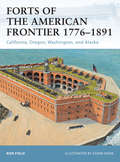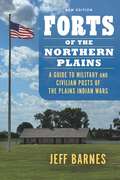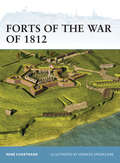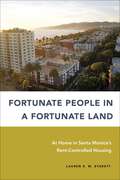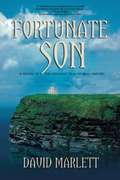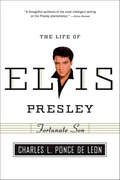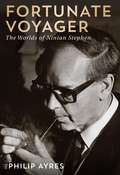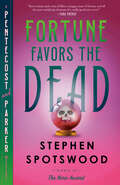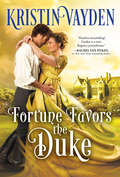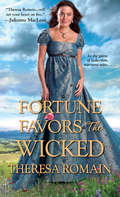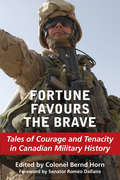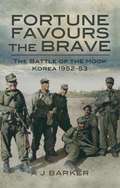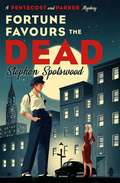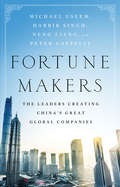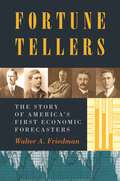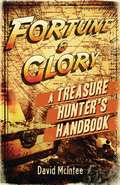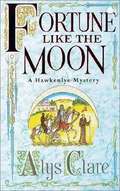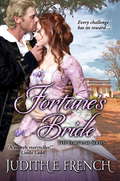- Table View
- List View
Forts of the American Frontier 1776-1891
by Adam Hook Ron FieldWith the violent separation between the United States and Britain which began in 1776, the new 'Americans' set off to fulfill their manifest destiny and rule their new land from coast to coast. As they pushed westward, they came into conflict with both natives and other European settlers, and began to build fortresses to defend their newly claimed land. This book charts the development and variation of the fortresses of the American Frontier, covering both American defenses and those of the Spanish in the west. It also examines the little-known forts of early Russian settlers on the Pacific coast.
Forts of the Northern Plains: A Guide to Military and Civilian Posts of the Plains Indian Wars
by Jeff BarnesAs the first official symbols of U.S. government presence on the western frontier, the forts of the northern plains were both centers of commerce and sources of conflict. The integral roles these forts played during decades of warfare with the Plains Indian tribes—and the fate of the posts after those wars ended—were essential to the expansion of the American West during this traumatic period of history. In Forts of the Northern Plains Jeff Barnes presents an informative guidebook to the forts of the Indian campaigns of the late nineteenth century. Focusing on sites in Iowa, Minnesota, Montana, Nebraska, North Dakota, South Dakota, and Wyoming, Barnes includes the forts&’ histories, descriptions of what remains today, directions, nearby points of interest, and visitor information for each post. This new expanded edition adds a number of federal sites designated as camps and posts, as well as civilian and militia sites that are marked. With new entries, color photographs, and updated information on the forts, as well as a rating system for traveler interests, Barnes provides an up-to-date guide of the historic military posts of the Indian Wars.
Forts of the War of 1812
by René Chartrand Donato SpedaliereWhen war broke out between the United States and Great Britain in 1812, neither side was prepared for the conflict, as evidenced by their respective fortifications. The most sophisticated and modern fortifications were those built by the US Corps of Engineers to protect some of the main port cities. These included Fort Mifflin in Philadelphia, Fort McHenry in Baltimore and Castle William in New York. The British also heavily fortified their main harbor at Halifax and their main center of power at Quebec. However, elsewhere, especially in the interior, fortifications were old, neglected or only hastily erected. The forts at Detroit and Mackinac were much as the British had left them in 1796. This book covers all of the main fortifications of the conflict, those that faced the crashing of guns and those whose intimidation played a part in the grand strategy of the war.
Fortuna, la mujer de la Conquista
by Mauricio Carrera"Fortuna, era su nombre. Verla y no perderse en imaginerías de alcoba resultaba imposible. Todo en ella era incitación al pecado, a la locura o a la pérdida de la voluntad propia."En medio de las cruentas y despiadadas batallas por dominar el Nuevo Mundo, salieron a escena las mujeres más aguerridas y valientes, aquellas que abandonaron los menesteres de casa por espadas y corazas; entre ellas, Fortuna, la más bella de todas, indomable y hábil jinete. En sus hazañas épicas fue testigo de un colosal encuentro de dos culturas, así como de la construcción de los bergantines y de las batallas navales que le otorgaron la victoria indudable a los de España, en un pasaje de suma importancia y poco conocido sobre la Conquista de México.Fortuna conoce a dos hombres, dos enemigos entre sí: a Martín López, al carpintero de los bergantines, artífice casi anónimo de la victoria española, y a Meshicayotl, un noble guerrero mexicano. Entre ellos se desata una conquista doble: por las tierras y por su amor, mientras el mundo prehispánico poco a poco se derrumba.Fortuna es una novela cautivadora que combina el romance con la guerra, el deseo con la sobrevivencia y la pasión con la rivalidad, donde Mauricio Carrera nos demuestra que no todo ha sido dicho sobre uno de los episodios más importantes y atractivos de la historia."Mauricio Carrera puede hacer lo que se le pega la gana en su arte narrativo".MÓNICA LAVÍN
Fortunate People in a Fortunate Land: At Home in Santa Monica's Rent-Controlled Housing (Urban Life, Landscape and Policy)
by Lauren E. EverettRent control and other tenant protections have profound and positive impacts on individuals’ and communities’ lives. Lauren Everett’s Fortunate People in a Fortunate Land shows how rent control impacts the lives of the renters themselves. Everett interviews residents about their experiences in low- and middle-income households in rent-controlled private market housing in Santa Monica, CA, a city where Everett was born and raised but can no longer afford to live. Everett seeks to understand the extent to which individuals feel at home or not at home and what factors contribute to those experiences. She also explores the nexus of Santa Monica’s tenant protection policies, infrastructure, and resources and the extent to which they inform stability—both perceived and actual—and life decisions. The first scholarly book to take a tenant-centered approach to examining the benefits and problems of rent control, Fortunate People in a Fortunate Land examines the residential experience in this specific local context and explains how it relates to policy and other externalities in cities where homeownership is not financially viable for most renters. In the series Urban Life, Landscape, and Policy
Fortunate Son
by David MarlettMeet James Annesley, son of 18th Century Ireland. Though you may have never heard his name before, his story has already touched you in profound ways. Now, for the first time, novelist David Marlett brings that incredible story to life.Stretching from the dirty streets of Ireland to the endless possibilities of Colonial America, from drama on the high seas with the Royal Navy to a life-and-death race across England and up the Scottish Highlands, from the prospect of a hangman's noose to a fate decided in the halls of justice, FORTUNATE SON is a powerful, relentless epic. Here nobility, duels, love, courage, revenge, honor, and treachery among family, friends and ancient enemies abound. And at its center is the most momentous trial in Irish history - the trial of Annesley v. Anglesea from which our modern "attorney/client privilege" was forged, and our concept of a "jury of one's peers" was put to the test.Carefully researched, vividly evoked, and lovingly brought to the page, FORTUNATE SON is an unforgettable work of fiction based on fact, one that will resonate deep within you long after you finish it.
Fortunate Son: The Autobiography of Lewis B. Puller, Jr.
by Lewis B. PullerLewis B. Puller, Jr., the son of the most decorated Marine in the Corps' history, volunteered for duty in Vietnam after college. He came home a few months later missing both legs, his left hand, and two fingers of his right hand. He would never walk again, though he would complete law school, serve on President Ford's clemency board, and run for Congress. He would also live with the nightmares of Vietnam, and his growing dependence on alcohol. Few have told their story with more honesty, or more devastating openness.<P><P> Pulitzer Prize Winner
Fortunate Son: The Life of Elvis Presley
by Charles L. Ponce de LeonElvis Presley was celebrity's perfect storm. His sole but substantial contribution was talent, a fact Charles L. Ponce de Leon is careful to demonstrate throughout his wonderfully contextual Fortunate Son. Even as the moments of lucidity necessary to exercise that talent grew rarer and rarer, Elvis proved his musical gifts right up to the end of his life. Beyond that, however, he was fortune's child. Fortunate Son succinctly traces out the larger shifts that repeatedly redefined the cultural landscape during the 1950s, 1960s, and 1970s, using Elvis's life to present a brief history of American popular culture during these tumultuous decades.
Fortunate Sons: The 120 Chinese Boys Who Came to America, Went to School, and Revolutionized an Ancient Civilization
by Matthew Miller Liel Leibovitz"Thoroughly enjoyable . . . an outstanding tale of cross-cultural fertilization." --Booklist In 1872, China--ravaged by poverty, population growth, and aggressive European armies--sent 120 boys to America to learn the secrets of Western innovation. They studied at New England's finest schools and were driven by a desire for progress and reform. When anti-Chinese fervor forced them back home, the young men had to overcome a suspicious imperial court and a country deeply resistant to change in technology and culture. Fortunate Sons tells a remarkable story, weaving together the dramas of personal lives with the fascinating tale of a nation's endeavor to become a world power.
Fortunate Voyager: The Worlds of Ninian Stephen
by Philip AyresOne life, many roles: soldier, brilliant barrister, High Court judge, Governor-General, Australian diplomat, mediator in Northern Ireland, member of the first war crimes tribunal since Nuremburg and Tokyo, head of UN and Commonwealth missions to crisis zones from Cambodia to Burma to Bangladesh, Sir Ninian Stephen is the recipient of five knighthoods and the most honoured Australian in history - and yet precisely because so much of his work was international it has rarely received the notice it deserves in his home country. In this, the first whole-of-life biography of the subject, Philip Ayres traces Stephen's early life in Scotland, England and around continental Europe, from Edinburgh and the Highlands to the spa towns of France and Germany, from the ski runs above Montreux to the Nuremberg Rally of 1938, including the details of his education at outstanding British and Swiss schools and his highly unorthodox "family" life as an only child with an absent father, the details of which, like so much here, have never previously been revealed. All this constitutes the unknown Ninian Stephen, and yet so much else in this book is new: the wartime Stephen, the barrister Stephen, and all the other aspects of his life traced in precise yet dramatic detail in a book whose momentum is generated through unique access to the full resources of the subject's personal papers.
Fortune Favors the Dead: A Novel (Pentecost And Parker Ser. #1)
by Stephen Spotswood"Bullets, blood, bodies, and belly-laughs: all the ingredients of a classic mystery novel. Stephen Spotswood hard-boils with the best of 'em!"--Alan Bradley, bestselling author of the Flavia de Luce Mystery SeriesA wildly charming and fast-paced mystery written with all the panache of the hardboiled classics, Fortune Favors the Dead introduces Pentecost and Parker, an audacious new detective duo for the ages.It's 1942 and Willowjean "Will" Parker is a scrappy circus runaway whose knife-throwing skills have just saved the life of New York's best, and most unorthodox, private investigator, Lillian Pentecost. When the dapper detective summons Will a few days later, she doesn't expect to be offered a life-changing proposition: Lillian's multiple sclerosis means she can't keep up with her old case load alone, so she wants to hire Will to be her right-hand woman. In return, Will is to receive a salary, room and board, and training in Lillian's very particular art of investigation. Three years later, Will and Lillian are on the Collins case: Abigail Collins was found bludgeoned to death with a crystal ball following a big, boozy Halloween party at her home--her body slumped in the same chair where her steel magnate husband shot himself the year before. With rumors flying that Abigail was bumped off by the vengeful spirit of her husband (who else could have gotten inside the locked room?), the family has tasked the detectives with finding answers where the police have failed. But that's easier said than done in a case that involves messages from the dead, a seductive spiritualist, and Becca Collins--the beautiful daughter of the deceased, who Will quickly starts falling for. When Will and Becca's relationship dances beyond the professional, Will finds herself in dangerous territory, and discovers she may have become the murderer's next target.
Fortune Favors the Duke (Cambridge Brotherhood #1)
by Kristin VaydenFor fans of Ella Quinn, Amelia Grey, and Bridgerton comes the first in a new historical romance series with all your favorite tropes:Friends to lovers romanceForbidden romanceReluctant dukesTight-knit family sagaThe new Duke has a proper scandal brewing.Quinton Errington is perfectly happy teaching at Cambridge, with his elder brother carrying the duties of being the Duke of Wesley. But when a trip to celebrate Wesley's last week of bachelorhood ends in tragedy, Quinton, who becomes the Duke, would give anything to have his brother back.Wesley's would-be bride, Catherine Greatheart, is left heartbroken and alone. Her grandmother has fallen ill, and Catherine has nowhere left to turn but to the family she was so close to being part of. The new Duke is kind, and she could use a friend.Between learning how to be the head of his family, mourning his brother, and trying not to fall in love with his late-brother's fiancée, Quinton will need some help—and it's a good thing he's not alone."Flawless storytelling! Vayden is a new Regency powerhouse."—Rachel Van Dyken, #1 New York Times bestselling author
Fortune Favors the Wicked (Royal Rewards #1)
by Theresa RomainAs a lieutenant in the Royal Navy, Benedict Frost had the respect of every man on board--and the adoration of the women in every port. When injury ends his naval career, the silver-tongued libertine can hardly stomach the boredom. Not after everything--and everyone--he's experienced. Good thing a new adventure has just fallen into his lap… When courtesan Charlotte Perry learns the Royal Mint is offering a reward for finding a cache of stolen gold coins, she seizes the chance to build a new life for herself. As the treasure hunt begins, she realizes her tenacity is matched only by Benedict's--and that sometimes adversaries can make the best allies. But when the search for treasure becomes a discovery of pleasure, they'll be forced to decide if they can sacrifice the lives they've always dreamed of for a love they've never known…
Fortune Favours the Brave: Tales of Courage and Tenacity in Canadian Military History
by Colonel Bernd Horn Senator Romeo DallaireMany Canadians see the role their country’s military plays in Afghanistan as an anomaly. However, this assumption is far from the truth. As U.S. Secretary of State Condoleezza Rice has commented, "Canadians are fierce fighters." Fortune Favours the Brave certainly proves this point in a collection of essays that showcases the fighting spirit and courage of Canada’s military. Daring actions featured in the book include the intrepid assault on the Fortress of Louisbourg and the cat-and-mouse struggle between Canadian partisans and Rogers’s Rangers in the Seven Years’ War in the 1750s; the seesaw battle for the Niagara frontier in the War of 1812; an innovative trench raid in the First World War; the valiant parachute assault to penetrate the Third Reich in the Second World War; the infamous battle at Kap’yong in the Korean War; covert submarine operations during the Cold War; the Medak Pocket clash in Croatia in the early 1990s; and Operation Medusa in Afghanistan.
Fortune Favours the Brave: The Battles of the Hook Korea, 1952–53 (Military History Ser.)
by A.J. BarkerAll too little remembered today, the Korean War was bitterly fought out under atrocious conditions of weather and terrain. Greatly outnumbered by their Communist Chinese and North Korean enemy, the United Nations forces fought with extraordinary resolve and gallantry. The Hook, the name given to a prominent ridge on the Peninsula, saw more blood spilt than any other feature in this prolonged and grisly war. Not surprisingly it became known as 'the bloody Hood'.The two costliest battles are described in detail in Fortune Favours The Brave, a classic account of the war. Both involved British infantry battalions of 29 Commonwealth Brigade. In November 1952, The Black Watch saw off a major Chinese attack against all odds. In May 1953 it was the turn of 1st Battalion, The Duke of Wellington's Regiment to face what must have seemed an overwhelming onslaught. Along a 1,000 yard front the greatest concentration of artillery fire since the Great War was brought to bear on Chinese human-wave attacks.In the morning the Dukes still held the ground despite heavy casualties. This feat of arms, achieved by battalion made up mainly of young National Servicemen from yorkshire, ranks among the finest in the long and glorious history of the British Army.
Fortune Favours the Dead: A dazzling murder mystery set in 1940s New York (Pentecost and Parker)
by Stephen SpotswoodThe 'razor-sharp' first book in the charming, fast-paced Pentecost and Parker mystery series. Book Two, Murder Under Her Skin, coming December 2021!Meet your new favourite duo, audacious and iconic, and perfect for fans of The Thursday Murder Club by Richard Osman, The Marvellous Mrs. Maisel, Agatha Christie and M. C. Beaton.It's 1945 and Lillian Pentecost is the most successful private detective in New York City, but she needs help. Enter Willowjean Parker, a circus runaway - and the perfect assistant. Quick-witted and street-smart, she's a jack-of-all-trades with a unique skill-set. She can pick locks blindfolded, wrestle men twice her size, and throw knives with deadly precision - all of which come in handy working for Ms P.When wealthy young widow Abigail Collins is murdered Pentecost and Parker are hired by the family to track down the culprit. On Halloween night, there was a costume party at the Collins' mansion, where a fortune teller performed a séance which greatly disturbed Abigail. Several hours later her body was discovered bludgeoned to death in her late husband's office. Problem is, the door to the office was locked from the inside. There was no-one else in the room, and the murder weapon was beside the victim; the fortune teller's crystal ball.It looks like an impossible crime, but Pentecost and Parker know there is no such thing...A 2020 Radio 2 Book Club pick.Praise for Fortune Favours the Dead:'Razor-sharp, tons of flair and a snappy sense of humour' Tana French'Bullets, blood, bodies, and belly-laughs: all the ingredients of a classic mystery novel. Stephen Spotswood hard-boils with the best of 'em!' Alan Bradley, bestselling author of the Flavia de Luce Mystery Series'Fortune Favours the Dead takes gritty 40s noir, shakes it up, gives it a charming twist, and serves it up with unforgettable style. My new favourite sleuthing duo.' Deanna Raybourn, author of the Veronica Speedwell Mysteries'Spotswood's stellar debut puts a modern spin on classic hard-boiled fiction. . . a novel to remember.' Publishers Weekly'This novel not only offers fun, offbeat characters and an exceptional flavour of the time, it's utterly charming too.' Woman's Weekly'This hugely enjoyable debut is a deft melange of Agatha Christie-style locked-room murder mystery and 1940s Chandler-esque pulp crime fiction with a feisty narrator' Irish Independent Review'A highly accomplished, auspicious first entry in what we must hope will be a long-running series' The Irish Times(P)2020 Penguin Audio
Fortune Favours the Dead: The Extremely Entertaining 2020 Radio 2 Book Club Pick (Pentecost and Parker #1)
by Stephen SpotswoodA 2020 Radio 2 Book Club pick. Perfect for fans of The Thursday Murder Club.'Razor-sharp, tons of flair. A really good noir novel.' Tana FrenchNew York, 1945. Lillian Pentecost is the most successful private detective in the city, but her health is failing. She hires an assistant to help with the investigative legwork. Willowjean Parker is a circus runaway. Quick-witted and street-smart, she's a jack-of-all-trades with a unique skill-set. She can pick locks blindfolded, wrestle men twice her size, and throw knives with deadly precision - all of which come in handy working for Ms P.When wealthy young widow Abigail Collins is murdered and the police are making no progress, Pentecost and Parker are hired by the family to track down the culprit. On Halloween night, there was a costume party at the Collins' mansion, where a fortune teller performed a séance which greatly disturbed Abigail. Several hours later her body was discovered bludgeoned to death in her late husband's office. Problem is, the door to the office was locked from the inside. There was no-one else in the room, and the murder weapon was beside the victim; the fortune teller's crystal ball. It looks like an impossible crime, but Pentecost and Parker know there is no such thing...Praise for Fortune Favours the Dead:'Spotswood's stellar debut puts a modern spin on classic hard-boiled fiction. . . The deep and sensitive characterization of the two protagonists, coupled with rich description and tonally spot-on humour, make this a novel to remember. Spotswood is definitely a writer to watch.' Publishers Weekly 'This novel not only offers fun, offbeat characters and an exceptional flavour of the time, it's utterly charming too.' Woman's Weekly 'This hugely enjoyable debut is a deft melange of Agatha Christie-style locked-room murder mystery and 1940s Chandler-esque pulp crime fiction with a feisty narrator' Irish Independent Review'Persuasive in its attention to period detail and dialogue, with well-constructed set piece scenes deftly staged, this is a highly accomplished, auspicious first entry in what we must hope will be a long-running series' The Irish Times
Fortune Like the Moon (Hawkenlye Medieval Mystery)
by Alys ClareIt is 1157, and a young nun from Hawkenlye Abbey has been found with her throat slashed. The people of rural Kent are quick to jump to conclusions: Surely the murderer must be one of the felons released by the new king, Richard Plantagenet, as a sign of his goodness and charity. When King Richard dispatches a soldier of fortune, Josse d'Acquin, to investigate the shockingly brutal crime, Josse understands that his true mission is to absolve the king from blame. But neither the king nor Josse has reckoned with the one person who is determined to find the truth at all costs--the remarkable Abbess of Hawkenlye, who ultimately joins with Josse to uncover the menace lurking behind the orderly facade of life in the convent and the surrounding manors. Fortune Like the Moon not only recreates the violence and beauty of medieval times but introduces a truly wonderful new pair of detectives.
Fortune Makers: The Leaders Creating China's Great Global Companies
by Michael Useem Peter Cappelli Harbir Singh Liang NengFortune Makers analyzes and brings to light the distinctive practices of business leaders who are the future of the Chinese economy. These leaders oversee not the old state-owned enterprises, but private companies that have had to invent their way forward out of the wreckage of an economy in tatters following the Cultural Revolution.Outside of brand names such as Alibaba and Lenovo, little is known, even by the Chinese themselves, about the people present at the creation of these innovative businesses. Fortune Makers provides sharp insights into their unique styles--a distinctive blend of the entrepreneur, the street fighter, and practices developed by the Communist Party--and their distinctive ways of leading and managing their organizations that are unlike anything the West is familiar with.When Peter Drucker published Concept of the Corporation in 1946, he revealed what made large American corporations tick. Similarly, when Japanese companies emerged as a global force in the 1980s, insightful analysts explained the practices that brought Japan's economy out of the ashes--and what managers elsewhere could learn to compete with them. Now, based on unprecedented access, Fortune Makers allows business leaders in the United States and the rest of the West to understand the essential character and style of Chinese corporate life and its dominant players, whose businesses are the foundation of the domestic Chinese market and are now making their mark globally.
Fortune Tellers: The Story of America's First Economic Forecasters
by Walter FriedmanA gripping history of the pioneers who sought to use science to predict financial marketsThe period leading up to the Great Depression witnessed the rise of the economic forecasters, pioneers who sought to use the tools of science to predict the future, with the aim of profiting from their forecasts. This book chronicles the lives and careers of the men who defined this first wave of economic fortune tellers, men such as Roger Babson, Irving Fisher, John Moody, C. J. Bullock, and Warren Persons. They competed to sell their distinctive methods of prediction to investors and businesses, and thrived in the boom years that followed World War I. Yet, almost to a man, they failed to predict the devastating crash of 1929.Walter Friedman paints vivid portraits of entrepreneurs who shared a belief that the rational world of numbers and reason could tame--or at least foresee--the irrational gyrations of the market. Despite their failures, this first generation of economic forecasters helped to make the prediction of economic trends a central economic activity, and shed light on the mechanics of financial markets by providing a range of statistics and information about individual firms. They also raised questions that are still relevant today. What is science and what is merely guesswork in forecasting? What motivates people to buy forecasts? Does the act of forecasting set in motion unforeseen events that can counteract the forecast made?Masterful and compelling, Fortune Tellers highlights the risk and uncertainty that are inherent to capitalism itself.
Fortune and Glory
by David Mcintee Hauke KockSo you've decided to give up the rat race for the life of an international treasure hunter, but you're not quite sure where to start. Well then, this book is for you! Fortune and Glory tells you all you need to know in order to set off on an epic quest for the great lost treasures of history. Starting with a quick exploration of the history of treasure hunting and a look at the supplies that you will need, it then delves into a survey of the 'lost' treasures that are out there just waiting to be claimed. Continent by continent, the book covers the legends of hidden locations like El Dorado, King Solomon's Mines, and the Sanctuary of Thoth, as well as covering the most illustrious lost artifacts such as the Holy Grail, the Hanjo Masamune, and the Crystal Skulls. If your interest lies with the loot rather than the history, the book also discusses Nazi gold, pirate treasure, and the hoard of Dracula. This book is your first step towards becoming the pistol-toting, fedora-wearing international tomb robber and treasure hunter you've always dreamt of being!
Fortune like the Moon (Hawkenlye Mysteries #1)
by Alys ClareShortly before his unexpected coronation, King Richard passed a law letting all of England's prisoners go free. Shortly afterwards, a young nun is found gruesomely murdered. Richard swiftly employs an old military colleague of his, Josse d'Acquin, to unravel this hideous mystery. Josse goes to Hawkenlye Abbey to find out the answers to these questions, and together with Abbess Helewise, they must find the murderer quickly, or they'll have the King of England to answer to.
Fortune's Bazaar: The Making of Hong Kong
by Vaudine EnglandA timely, well-researched, and vibrant new history of Hong Kong that reveals the untold stories of the diverse peoples who have made it a multicultural world metropolis-and whose freedoms are endangered today.Hong Kong has always been many cities to many people: a seaport, a gateway to an empire, a place where fortunes can be dramatically made or lost, a place to disappear and reinvent oneself, and a mixing pot of diverse populations from literally everywhere around the globe. A British Crown Colony for 155 years, Hong Kong is now ruled by the Chinese Communist Party who continues to threaten its democracy and put its rich legacy at risk. Here, renowned journalist Vaudine England delves into Hong Kong's complex history and its people-diverse, multi-cultural, cosmopolitan-who have made this one-time fishing village into the world port city it is today.Rather than a traditional history describing a town led by British Governors or a mere offshoot of a collapsing Chinese empire, Fortune's Bazaar is the first thorough examination of the varied peoples who made Hong Kong. While British traders and Asian merchants had long been busy in the Indian and South East Asian seas, there were many from different cultures and ethnic backgrounds who arrived in Hong Kong, met and married-despite all taboos-and created a distinct community. Many of Hong Kong's most influential figures during its first century as a city were neither British nor Chinese-they were Malay or Indian, Jewish or Armenian, Parsi or Portuguese, Eurasian or Chindian-or simply, Hong Kongers. England describes those overlooked in history including the opium-traders who built synagogues or churches, ship-owners carrying gold-rush migrants, property tycoons, and more. Here, too, is the visionary who plumbed Hong Kong's harbor depths to spur reclamation, the half-Dutch Chinese gentleman with two wives who was knighted by Queen Victoria, and the landscape gardeners who settled Kowloon and became millionaires.A story of empire, race, and sex, Fortune's Bazaar combines deep archival research and oral history to present a vivid history of a special place-a unique city made by diverse people of the world, whose part in its creation has never been properly told until now.
Fortune's Bazaar: The Making of Hong Kong
by Vaudine EnglandA timely, well-researched, and &“illuminating&” (The New York Times Book Review) new history of Hong Kong that reveals the untold stories of the diverse peoples who have made it a multicultural world metropolis—and whose freedoms are endangered today.Hong Kong has always been many cities to many people: a seaport, a gateway to an empire, a place where fortunes can be dramatically made or lost, a place to disappear and reinvent oneself, and a melting pot of diverse populations from around the globe. A British Crown Colony for 155 years, Hong Kong is now ruled by the Chinese Communist Party. Here, renowned journalist Vaudine England delves into Hong Kong&’s complex history and its people—diverse, multi-cultural, cosmopolitan—who have made this one-time fishing village into the world port city it is today. Rather than a traditional history describing a town led by British Governors or a mere offshoot of a collapsing Chinese empire, Fortune&’s Bazaar is &“a winning portrait of Hong Kong&’s vibrant mosaic&” (Publishers Weekly). While British traders and Asian merchants had long been busy in the Indian and South East Asian seas, many people from different cultures and ethnic backgrounds arrived in Hong Kong, met, and married—despite all taboos—and created a distinct community. Many of Hong Kong&’s most influential figures during its first century as a city were neither British nor Chinese—they were Malay or Indian, Jewish or Armenian, Parsi or Portuguese, Eurasian or Chindian—or simply, Hong Kongers. England describes those overlooked in history, including the opium traders who built synagogues and churches; ship owners carrying gold-rush migrants; the half-Dutch, half-Chinese gentleman with two wives who was knighted by Queen Victoria; and the gardeners who settled Kowloon, the mainland peninsula facing the island of Hong Kong, and became millionaires. A story of empire, race, and sex, Fortune&’s Bazaar presents a &“fresh…essential&” (Ian Buruma), &“formidable and important&” (The Correspondent) history of a special place—a unique city made by diverse people of the world, whose part in its creation has never been properly told until now.
Fortune's Bride
by Judith E. FrenchIn a time of revolution, a fiery young widow may have to compromise more than her politics...As British soldiers swarm her Maryland plantation, Caroline Steele must feign loyalty to the Crown to protect her home. But she is in danger of losing everything when a fugitive chooses her bedroom as his hiding place--and effectively ruins her reputation. Now the scoundrel owes Caroline his life--a debt she demands he pay--with marriage...Rebel sea captain Garrett Faulkner never planned to take a wife. But Caroline has him undeniably trapped--and tempted. With the British on his heels, and a murderous suitor after her fortune, both have much to lose--and more to gain than their hearts dare imagine. For marriage is merely one part of a bargain filled with secrets, adventure--and irresistible desire...150,000 Words
